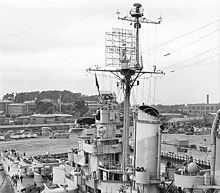27:
238:, particularly in the Pacific Theater, with about 1000 units produced during the war, and remained in service for about 2 decades. Designed for installation on destroyers and larger ships to search for low-flying warplanes and surface ships, it achieved greatly improved surface coverage and detection of aircraft compared with previous lower frequency radars. It also proved a superior navigation aid, making possible the detection of buoys and shoreline at night or bad weather.
242:
377:
411:
416:
360:
26:
341:
322:
406:
92:
213:
209:
284:
198:
249:: "A display" of return signal versus time, gyrocompass readout, and PPI (Plan Position Indicator) display
401:
172:
77:
228:
183:
36:
356:
337:
318:
217:
176:
286:
Evolution of Naval Radio-electronics and
Contributions of the Naval Research Laboratory
221:
241:
395:
180:
139:
353:
Radar
Origins Worldwide: History of Its Evolution in 13 Nations Through World War II
378:"US Radar: Operational Characteristics of Radar Classified by Tactical Application"
235:
225:
194:
102:
205:
197:) frequencies and the first surface-search radar to be equipped with a
32:
169:
190:
315:
A Radar
History of World War II: Technical and Military Imperatives
240:
201:(PPI), the ancestor of virtually all modern radar displays.
317:. Bristol and Philadelphia: Institute of Physics Publishing.
220:
technology developed in
Britain and brought to the US by the
245:
Operating console. The three large round displays are
179:. The first operational set was installed aboard the
35:(below and to the left of the SG) radar antennas of
154:
146:
134:
126:
118:
101:
91:
83:
73:
62:
54:
46:
189:in April 1942. It was the first Navy radar to use
412:Military equipment introduced from 1940 to 1944
224:. The prototype was tested at sea aboard the
234:in May 1941. It saw extensive use during
8:
289:. US Naval Research Laboratory. p. 187.
19:
25:
18:
278:
276:
274:
272:
175:for large warships developed during the
259:
7:
417:Military radars of the United States
380:. Naval History and Heritage Command
14:
336:. London: Conway Maritime Press.
31:SG (at the top of the mast) and
351:Watson, Raymond C. Jr. (2009).
63:
1:
16:American surface-search radar
204:The radar was developed by
433:
283:Gebhard, Louis A. (1979).
208:under the guidance of the
332:Friedman, Norman (1981).
214:Naval Research Laboratory
24:
210:MIT Radiation Laboratory
150:200 yd (180 m)
142:(28 km; 17 mi)
216:using the cutting-edge
199:plan position indicator
250:
47:Country of origin
313:Brown, Louis (1999).
244:
218:multicavity magnetron
173:surface-search radar
78:Surface-search radar
407:World War II radars
21:
251:
362:978-1-4269-2111-7
162:
161:
109:5.6° (horizontal)
424:
388:
386:
385:
366:
347:
328:
300:
297:
291:
290:
280:
267:
266:Friedman, p. 148
264:
177:Second World War
97:775, 800, or 825
65:
29:
22:
432:
431:
427:
426:
425:
423:
422:
421:
392:
391:
383:
381:
376:
373:
371:Further reading
363:
350:
344:
331:
325:
312:
309:
304:
303:
298:
294:
282:
281:
270:
265:
261:
256:
247:(left to right)
42:
17:
12:
11:
5:
430:
428:
420:
419:
414:
409:
404:
394:
393:
390:
389:
372:
369:
368:
367:
361:
348:
342:
329:
323:
308:
305:
302:
301:
299:Watson, p. 212
292:
268:
258:
257:
255:
252:
222:Tizard Mission
160:
159:
156:
152:
151:
148:
144:
143:
136:
132:
131:
128:
124:
123:
120:
116:
115:
114:
113:
112:15° (vertical)
110:
105:
99:
98:
95:
89:
88:
85:
81:
80:
75:
71:
70:
67:
60:
59:
56:
52:
51:
48:
44:
43:
30:
15:
13:
10:
9:
6:
4:
3:
2:
429:
418:
415:
413:
410:
408:
405:
403:
400:
399:
397:
379:
375:
374:
370:
364:
358:
354:
349:
345:
343:0-85177-238-2
339:
335:
330:
326:
324:0-7503-0659-9
320:
316:
311:
310:
306:
296:
293:
288:
287:
279:
277:
275:
273:
269:
263:
260:
253:
248:
243:
239:
237:
233:
232:
227:
223:
219:
215:
211:
207:
202:
200:
196:
192:
188:
187:
182:
181:heavy cruiser
178:
174:
171:
167:
157:
153:
149:
145:
141:
137:
133:
129:
125:
121:
117:
111:
108:
107:
106:
104:
100:
96:
94:
90:
86:
82:
79:
76:
72:
68:
61:
57:
53:
50:United States
49:
45:
41:
40:
34:
28:
23:
402:Naval radars
382:. Retrieved
355:. Trafford.
352:
333:
314:
307:Bibliography
295:
285:
262:
246:
230:
203:
185:
165:
163:
38:
334:Naval Radar
236:World War 2
130:4, 8, or 12
396:Categories
384:2022-02-18
119:Pulsewidth
55:Introduced
229:USS
226:destroyer
195:microwave
184:USS
147:Precision
103:Beamwidth
84:Frequency
37:USS
206:Raytheon
166:SG radar
138:15
122:1.3–2 μs
20:SG radar
186:Augusta
170:US Navy
39:Astoria
359:
340:
321:
231:Semmes
191:S-band
168:was a
254:Notes
158:50 kW
155:Power
135:Range
87:3 GHz
66:built
357:ISBN
338:ISBN
319:ISBN
212:and
164:The
74:Type
58:1942
33:SK-1
140:nmi
127:RPM
93:PRF
69:955
64:No.
398::
271:^
387:.
365:.
346:.
327:.
193:(
Text is available under the Creative Commons Attribution-ShareAlike License. Additional terms may apply.

